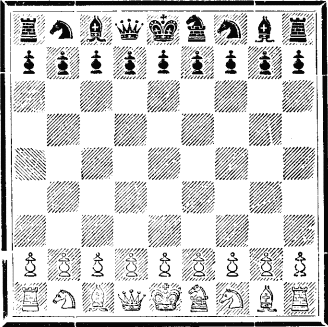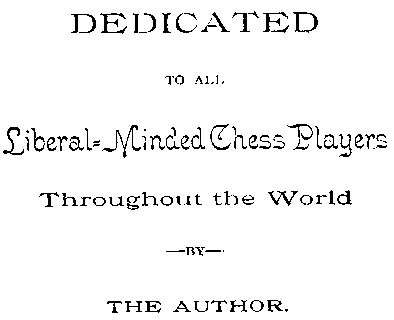PREFACE.
We make no apology for appearing before
the public in the capacity of an author. We
believe and know that we are advancing the
cause of chess in the introduction of a new piece,
which we are pleased to call the Chancellor,
and in the enlargement of the board to eighty-
one squares. Very many at first ridiculed the
innovation, but as soon. as they examined into
the merits of the Chancellor and his new board,
they at once, like sensible folk, became his
warm supporters. In the following pages we
will try to give as briefly as possible our ideas
on the subject of "Chancellor Chess," its
history, games, ending positions, problems,
etc., hoping that we may do a little good for
"the game of kings and king of games."
CHANCELLOR CHESS.
HISTORY.
As every chess player well knows, chess is as old
as India, having originated in that distant land before
the hanging gardens of Babylon were designed or the
towers of Persepolis erected. At first pieces in the
shape of animals, but afterwards changed to the
modern figures were used, some of them had different
movements from those at the present time, and boards
of various shapes and sizes were adopted. The game
was played under varying laws until the modern game
resulted, considered by the majority of chess players
as its best development. But some thinking spirits
weary of the old and monotonous debuts and not believing that the game has reached perfection, have originated a new piece called the Chancellor, which shall
have the moves of the rook and knight and increased
the chess board to eighty-one squares, nine on a side,
for the purpose of giving his majesty more room for
exercising his power.
There are four instances where the Chancellor under
different names was used on different boards.
Carrera in 1617 inserted two new pieces, a Campione,
having the moves of rook and knight, to be placed
between the king's rook and king's knight and a
centaur, combining the moves of bishop and knight
placed between the queen's rook and queen's knight
on a board 10x8 squares,
The Duke of Rutland in 1747 used a board 10x14
squares and introduced two new pieces, a Concubine.
possessing the power of rook and knight and a
crowned rook with the moves of king and rook.
L. Tressan, of Leipsic, in 1840 played on a board
11x11 with three additional pieces, an adjutant moving' as bishop and knight combined, a general with the
move of the queen and knight united, and a Marshal
having the moves of rook and knight.
And several years ago Mr. H. E. Bird, the veteran
chess master, suggested a board 10x8 and two new
pieces, a Guard (R and Kt) and equerry (B. and Kt.,
the former placed by the side of the queen and the latter by the side of the king, all other pieces remaining in
the same positions.
The Campione, the Concubine, the Marshal and the
Guard were old names for the Chancellor.
Our Claims to Originality.
In view of the above remarks, the wiseacres tell us
that the idea of the Chancellor is as old as the hills.
Well, what is not old? The ancient sage says. ''There
is nothing new under the sun." Steam was old,
gravity was old, electricity was old. and printing was
old when Watt, and Newton, and Morse, and Gutenberg applied them respectively for the benefit of mankind. One can easily conceal his weakness and
ignorance under the cover of "History tells us," and
attempt to chuckle at and condemn any innovation
that will improve the world. Such a person is not
productive of good, and is only a worthless appendage
to society. But the man who has the courage, and
ingenuity, and originality to combine old ideas and
put them into a tangible form which can be utilized;
he is the one who gains reputation and ameliorates
mankind.
In presenting, therefore, this seemingly ugly but
very powerful chess piece before the public, we do
not claim that the idea is new, but hold that it does
not matter who first thought of it, which had probably
been in the minds of chess players ever since the incipiency of the game. The construction of the piece,
the putting of it into type, the making use of it in
problems, the playing of games with it, and the
enlargement of the chess-board to eighty-one squares
-- each and every one is a claim that entitles us to
being the inventor of the Chancellor and Chancellor Chess.
The New Game Described.
The following article together with the problem first
appeared in the St. Louis Globe-Democrat, February 12,
1887, and at that time created quite a stir in the chess
world. We give it in full. accompanied by the comments of the leading newspapers, chess magazines and
chess players. The new game of chess is clearly described therein and needs no supplementary remarks
of ours:
POSITION OF MEN.
Black.
 White.
(Eighty-one squares.)
White.
(Eighty-one squares.)
In view of the recent and. thorough analyses of the
openings in chess, we propose that the chess-board be
changed to nine squares on a side, and that a pawn
and a piece, called the chancellor, having the power of
the rook or the knight, be added to the game.
The board will then have a black square in each
corner, and will always be in position for play. The
arrangement of the white pieces at the beginning of
the game will be in the following order, namely: R,
Kt, B, Q, K, C, Kt, B, R, with a pawn in front of each.
The R's will be on black squares; the Kt's and B's
on opposite colored squares, the Q B being; next to
the Q, and the K. Kt next to the C; the Q and C will
be on either side of the K, which will be on a black
square and be equally removed from the rooks. The
black pieces will be directly opposite the white. The
chancellor, so called because that magistrate is next
to the king in power and importance, can jump like a
knight and move like a rook. The same rules will
apply to the new game that have been used to govern
the old. Castling will be done exactly alike with either
rook, the K's rook, however, castling like the Q's
rook. The pawns when moved up two squares on
either side, will have a rank of squares intervening.
In the now game every player, for a while, will be
put on his own resources, and an endless variety of
pleasure will be found in discovering the safe lines of
play. Of course the present masters will frown it
down, because they can not afford to throw aside all
their investigations and call them lost -- only apparently lost, however, for their labors have led to this
innovation. But there is no doubt that the addition
of the chancellor gives symmetry and perfection to
the game. The queen has the power of a bishop and
a rook, and another piece having the power of a
knight and a rook was needed to equalize the force
on the king's side. and we have, therefore, at the suggestion of a friend introduced it with the hope that it
may be speedily and universally adopted.
And what a glorious field will be opened to problemists! Many a problem theme has had to be necessarily abandoned on account of the narrow limits of
the board and on account of its lacking originality.
With a new and powerful piece and a larger board,
what grand, original combinations will result! We
asked Mr. A. H. Robbins, our St. Louis problemist, to
construct a problem and use the chancellor. He has
done so. We give it in to-day's issue. Those who
desire to examine the position should invert a rook
and use it for the new piece.
Various forms for the chancellor have been suggested. It may be made to have a rook for the base,
and a knight for the top, and the queen changed into
a rook crowned with a bishop. Supposing the Q to
remain the same, the C could be made similar to it,
but have a projection on top.
Some say that the old game is sufficient for the ordinary player. We answer that the same argument
can be applied to the harpsichord by those who object
to the piano-forte of to-day.
The objection that it will take a longer time to play
the game because thirty-six men are used instead of
thirty-two, will not stand; for when the queens are
exchanged in the early part of the present game, it is
prolonged ad infinitum and becomes dull and uninteresting, whereas, if they are retained, it is more lively
and usually shorter. Add, therefore, another piece of
great power, and still shorter and more sprightly
games will be the consequence.
Now, dear chess friends, do not be too prejudiced
against this innovation, and condemn it because it is
new without examining into its advantages, which we
have set forth. Think how much more beautiful and
symmetrical and scientific the royal game will appear,
how many more mating positions and ingenious problems will be formed, and how infinite will be the combinations. We propose to publish a game of the new
kind and show to our readers what we can do with
the new piece. Whether or not the fossil chess
players will adopt it does not matter, undoubtedly the
problem students will at once make use of it; and
we predict that ere long every problemist of note will
be adding to his list of productions problems having
the chancellor.
It is our intention to start a tourney in which the
chancellor will have to be used in the construction of
all problems entered in it. The full conditions will
be shortly announced.
Chess players, composers and solvers interested in
our new ideas are requested to communicate with us
and make any suggestions they may think proper.
Let us have the subject discussed pro and con.
TOURNEY PROBLEMS
PROBLEM No. 1.
MOTTO: "VIVE LE CHANCELLIER"
By WM. L. FERRIS, New York City.
Black, three pieces.
       
       
       
       
       
       
       
       
White, four pieces.
White to play and mate in two moves.
Solution.
PROBLEM No. 3.
(First Prize Two-Move Problem.)
MOTTO: "WHO ARE YOU?"
By John Keeble, Norwich, England.
Black, eight pieces.
       
       
       
       
       
       
       
       
White, eight pieces.
White to play and mate in two moves.
Solution.
PROBLEM No. 4.
(Second Prize Two-Move Problem.)
MOTTO: "A CIRCUS."
By Eugene Woodward, So. Granville, N. Y.
Black, six pieces.
       
       
       
       
       
       
       
       
White, seven pieces.
White to play and mate in two moves.
Solution.
PROBLEM No. 9.
(First Prize Three-Move Problem.)
MOTTO: "VIVAT CHANCELLARIUS."
By L. H. JOKISCH, Centralia, Ill.
Black, one piece.
       
       
       
       
       
       
       
       
White, five pieces.
White to play and mate in three moves.
Solution.
|



 White.
(Eighty-one squares.)
White.
(Eighty-one squares.)